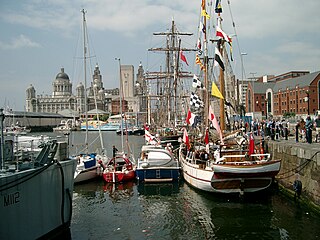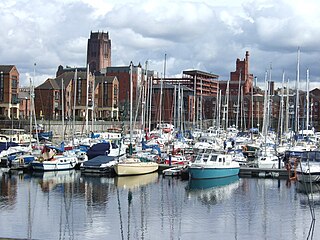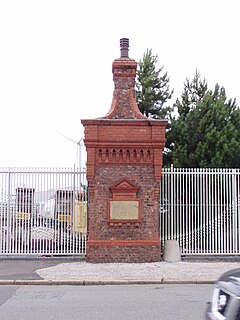
Seaforth Dock is a purpose-built dock and container terminal, on the River Mersey, England, at Seaforth, to the north of Liverpool. As part of the Port of Liverpool and Liverpool Freeport, it is operated by the Mersey Docks and Harbour Company. Situated at the northern end of the dock system, it is connected to Gladstone Dock to the south, which via its lock entrance provides maritime access to Seaforth Dock from the river.

Gladstone Dock is a dock on the River Mersey, England, and part of the Port of Liverpool. It is situated in the northern dock system in Bootle. The dock is connected to Seaforth Dock to the north and what remains of Hornby Dock to the south. Part of Liverpool Freeport, Gladstone Dock is operated by the Mersey Docks and Harbour Company.

Alexandra Dock is a dock on the River Mersey, England, and part of the Port of Liverpool. It is situated in the northern dock system in Bootle. Alexandra Dock consists of a main basin nearest the river wall and three branch docks to the east, with the southern branch mostly filled in.

Langton Dock is a dock on the River Mersey, England, and part of the Port of Liverpool. It is situated in the northern dock system in Bootle, connected to Alexandra Dock to the north and Brocklebank Dock to the south. Langton Dock locks provide a working connection to the river; one of the two remaining operational river entrances in the northern dock system.

Brocklebank Dock is a dock on the River Mersey, England, and part of the Port of Liverpool. It is situated in the northern dock system in Bootle, connected to Langton Dock to the north and Canada Dock to the south. Carriers' Dock was originally sited to the east.

Huskisson Dock is a dock on the River Mersey, England, which forms part of the Port of Liverpool. It is situated in the northern dock system in Kirkdale. Huskisson Dock consists of a main basin nearest the river wall and two branch docks to the east. It is connected to Canada Dock to the north and Sandon Half Tide Dock to the south.

Bramley-Moore Dock is a dock on the River Mersey, England, and part of the Port of Liverpool. The dock is located in the northern dock system in Vauxhall, connected to Sandon Half Tide Dock to the north and Nelson Dock to the south. Jesse Hartley was the architect with opening in 1848.

Nelson Dock is a dock on the River Mersey, England, and part of the Port of Liverpool. It is situated in the northern dock system in Vauxhall, connected to Bramley-Moore Dock to the north and Salisbury Dock to the south.

Salisbury Dock is a dock on the River Mersey, England, and part of the Port of Liverpool. It is situated in the northern dock system in Vauxhall and is connected to Nelson Dock to the north, Trafalgar Dock to the south and inland to Collingwood Dock.

Collingwood Dock is a dock on the River Mersey, in England, and part of the Port of Liverpool. It is situated in the northern dock system in Vauxhall, and is connected to Stanley Dock to the east and Salisbury Dock to the west.

Prince's Dock is a dock on the River Mersey, England, and part of the Port of Liverpool. It is the most southerly of the docks situated in the northern part of the Liverpool dock system, connected to Prince's Half-Tide Dock to the north. The dock is now in the buffer zone to one of Liverpool's World Heritage Sites.

Canning Dock on the River Mersey is part of the Port of Liverpool in Northern England. The dock is in the southern dock system, connected to Salthouse Dock to the south and with access to the river via the Canning Half Tide Dock to the west. The Canning Graving Docks are accessed from the dock.

Coburg Dock is a dock on the River Mersey, in England, and part of the Port of Liverpool. It is situated in the southern dock system, connected to Queens Dock to the north, Brunswick Dock to the south.

Brunswick Dock is a dock on the River Mersey, in England, and part of the Port of Liverpool. It is situated in the southern dock system, connected to Coburg Dock to the north, Toxteth Dock to the south.

Toxteth Dock was a dock on the River Mersey that was part of the Port of Liverpool. Part of the southern dock system, it was connected to Brunswick Dock to the north and Harrington Dock to the south.

Harrington Dock was a dock on the River Mersey and part of the Port of Liverpool. Situated in the southern dock system, it was connected to Toxteth Dock to the north and Herculaneum Dock to the south.

Duke's Dock is a dock on the River Mersey, England, and part of the Port of Liverpool. It is in the southern dock system, connected to Salthouse Dock and Wapping Dock to the east. The Albert Dock is located immediately north, although not directly accessible by water.

Carriers' Dock was a dock on the River Mersey, England, and part of the Port of Liverpool. The dock was situated in the northern dock system and connected to Brocklebank Dock to the west.

The Old Dock, originally known as Thomas Steers' dock, was the world's first commercial wet dock. The 3 1⁄2 acres (1.4 ha) dock was built on the River Mersey in Liverpool, England, starting in 1710 and completed in 1716. A natural tidal pool off the river Mersey, which probably gave its name to Liverpool centuries earlier, was partially filled and locked in from the river with quay walls erected.

Sandon Dock was a dock on the River Mersey, England, and part of the Port of Liverpool. Situated in the northern dock system, it was east of Sandon Half Tide Dock, to which it was once connected.






























